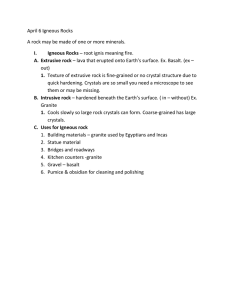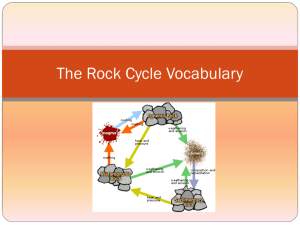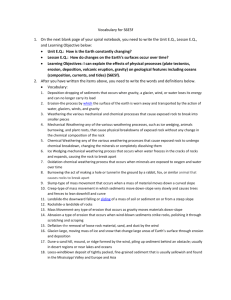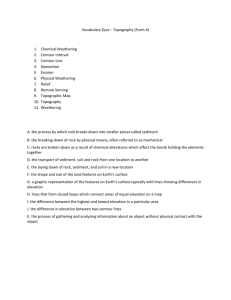Earth's Changing Surface Study Guide Answers
advertisement
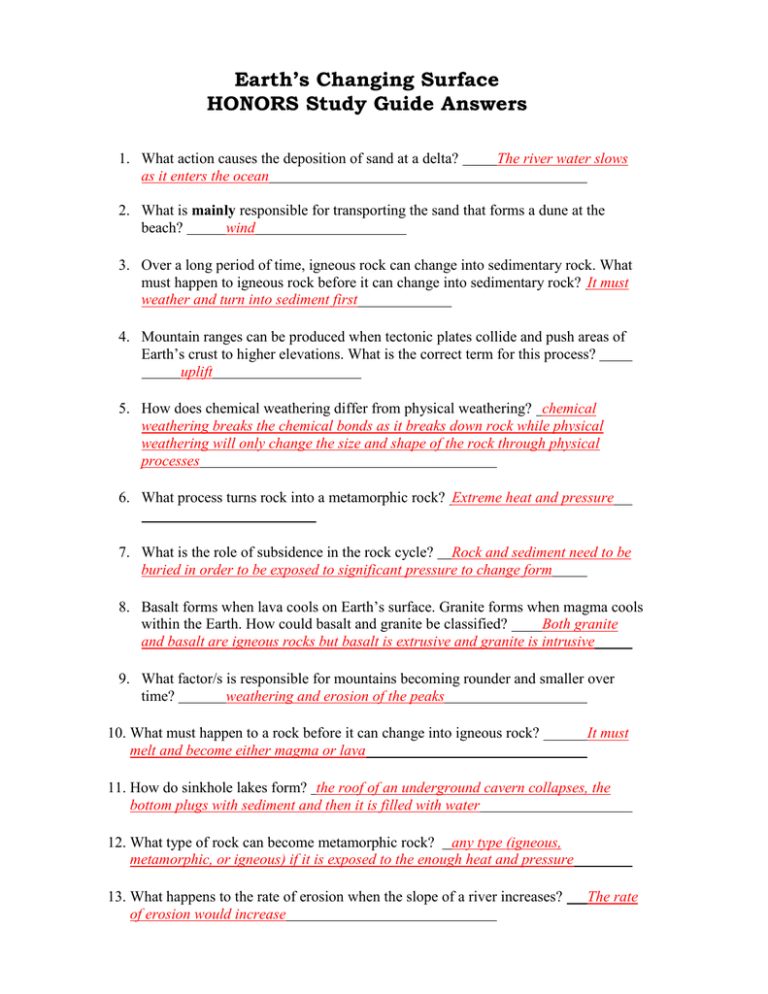
Earth’s Changing Surface HONORS Study Guide Answers 1. What action causes the deposition of sand at a delta? as it enters the ocean The river water slows 2. What is mainly responsible for transporting the sand that forms a dune at the beach? wind 3. Over a long period of time, igneous rock can change into sedimentary rock. What must happen to igneous rock before it can change into sedimentary rock? It must weather and turn into sediment first 4. Mountain ranges can be produced when tectonic plates collide and push areas of Earth’s crust to higher elevations. What is the correct term for this process? uplift 5. How does chemical weathering differ from physical weathering? chemical weathering breaks the chemical bonds as it breaks down rock while physical weathering will only change the size and shape of the rock through physical processes 6. What process turns rock into a metamorphic rock? Extreme heat and pressure 7. What is the role of subsidence in the rock cycle? Rock and sediment need to be buried in order to be exposed to significant pressure to change form 8. Basalt forms when lava cools on Earth’s surface. Granite forms when magma cools within the Earth. How could basalt and granite be classified? Both granite and basalt are igneous rocks but basalt is extrusive and granite is intrusive 9. What factor/s is responsible for mountains becoming rounder and smaller over time? weathering and erosion of the peaks 10. What must happen to a rock before it can change into igneous rock? melt and become either magma or lava It must 11. How do sinkhole lakes form? the roof of an underground cavern collapses, the bottom plugs with sediment and then it is filled with water 12. What type of rock can become metamorphic rock? any type (igneous, metamorphic, or igneous) if it is exposed to the enough heat and pressure 13. What happens to the rate of erosion when the slope of a river increases? of erosion would increase The rate 14. How does sediment from the mountains in Georgia reach Florida? the sediment travels in the rivers and streams 15. What type of rock would erode faster? Gentle waves hitting hard rock Rough waves hitting hard rock Gentle waves hitting soft rock Rough waves hitting soft rock 16. How does the mass, roundness, and shape of a sediment particle change as it is transported in a river over a long distance? Abrasion causes the sediment particle to become smaller, rounder, and smoother as it crashes into other rocks as it moves downstream 17. After a storm, why might there be larger rocks and pebbles in a river that is normally full of fine sediment? The storm would have increased the rate of erosion washing larger sediment downstream 18. What usually happens to river sediments when there has been little rain and the water level of the river is low? There is little movement of sediment because the rate of erosion decreases 19. Leaves release acids into the soil as they decay. How could the decaying leaves affect the rocks in the soil underneath them? The acids from the decaying leaves break down the chemical bonds in the rock (chemical weathering) 20. Describe how a river can cause a canyon to form. over a significant period of time, water running across the surface slowly erodes the surface building a deep canyon or valley 21. How have glaciers impacted Florida? as ancient glaciers melted, it caused the sea level to rise covering land masses at lower elevations. Florida might have been much larger millions of years ago 22. Why are floodplains so fertile? Nutrient-rich sediment from the river bed run on the plains when the river floods giving the plants plenty of the nutrients that they need to grow
